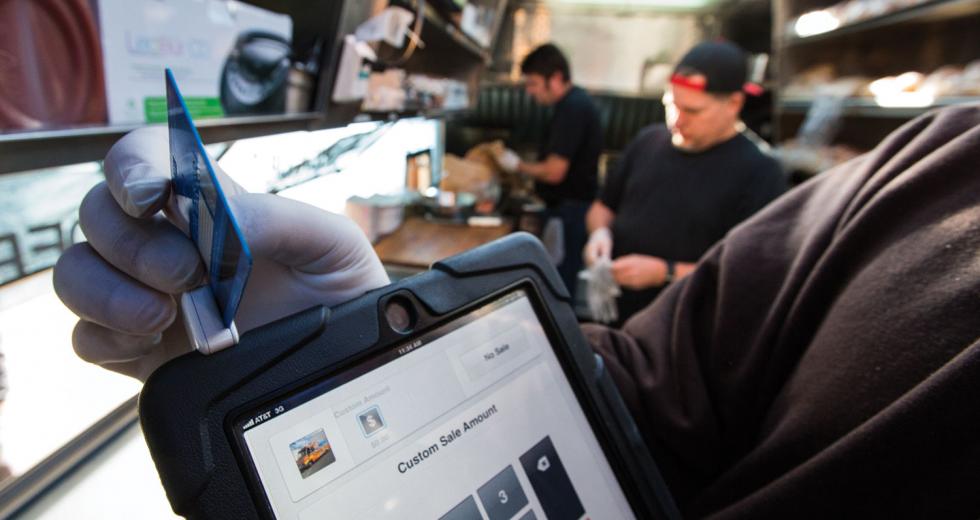On a drizzly afternoon in downtown Sacramento, Drewski’s Hot Rod Kitchen is hard to miss.
The food truck’s orange flames blaze along its sides and stand out against the muted surroundings as the smoke and smells rising from pulled pork, Korean braised beef and grilled cheese waft through the rain at 12th and O streets.
Weather is just one issue Drewski’s owner Andrew Blaskovich is dealing with today. The other is finding a new place to park in accordance with city rules. Blaskovich is almost always on the move.
But after dealing with parking, inclement weather and the limited space to prep and cook on the truck, one thing Blaskovich does not have to worry about is how his customers pay for their food.
That’s because shortly after hitting the road for the first time in April 2011, Blaskovich started using Square, a mobile credit card reader that plugs into a smartphone or tablet computer headphone jack and allows businesses to process credit transactions on the spot. Square charges a 2.75-percent fee per swipe or, for businesses with more transactions, a flat rate per month or per year. It’s relatively affordable, plus it’s easy and dependable.
“The majority of our sales are credit card-based because nobody carries cash anymore,” says Blaskovich as he reaches into his jean pockets, extracting only a few crumpled pieces of paper. “I mean, I don’t have any cash in my pocket. Everything on the card is more convenient.”
Square isn’t the only company in today’s merchant-service market that offers mobile point-of-sale technology, but it is by far the largest in the Sacramento region, with more than 10,000 users in this area alone. Its recent partnership with Starbucks, a mammoth $25 million deal that was announced in August and will allow customers to pay via Square in 7,000 of the coffee giant’s U.S. stores, puts Square at the head of the pack.
But companies like PayPal, VeriFone, Intuit and PayAnywhere also offer similar mobile card readers — many with lower per-swipe rates. And new options continue to emerge in the growing market.
In an age where cash is less and less favored by average consumers, this technology is having an enormous impact on businesses that would otherwise be unable or unwilling to accept alternative forms of payment. And many local businesses — large and small, mobile or fixed — are taking advantage.
Kathy Turner has been selling shirts for her business, T-Shirt Lady, for 23 years. She produces all of her clothing in her El Dorado Hills home studio and sells the attire in the fall at Apple Hill.
This September, Turner began using Square on her iPad for the first time.
“Because I deal with an older crowd, they were a little afraid of it,” Turner says. “They’d never seen it. Some of (my customers) were a little nervous. They said, ‘Is that really secure?’ But they still used it. Just being able to offer credit always increases your sales when you have that ability.”
Mobile credit technology is part of the progressive and seemingly inevitable move away from cash as more people turn to alternative payment methods, says Dr. Suzanne O’Keefe, department chair and professor of economics at Sacramento State University.
Square’s Square Wallet app allows customers to pay with their phone simply by stating their name at the cash register, and their real-time analytics of sales when using the Square Register allow companies to adjust immediately.
“As the generations mature and we become the new old generation, we’ll only see that card payments become used by everybody, O’Keefe says.
“The fees might be a little higher for the small business that has fewer transactions, and that will eat into their bottom line. But the overall trade-off might make it worthwhile. It’s a lot easier to use and creates less errors potentially than using cash or checks.”
Convenience is just part of the tradeoff that makes smartphone and tablet-based credit systems appealing to businesses, including brick-and-mortar establishments. Square’s Square Wallet app for iPhone or Android allows users to open “merchant cards” with participating businesses. The app is connected to the user’s banking information and the merchant’s Square account. Any time a user wants to pay for something, they can simply state their name at the register, and they never have to reach for their wallet. On the merchant’s end, the Square Register feature provides access to sales reports and the ability to wirelessly print receipts or open a cash drawer to make change. Analytics allow merchants to segment consumer payments data and transactions, and users can access transaction information, including number of payments made, subtotals, tax, tips, refunds, account deposits, etc.
“Until now, many companies had no way to track important sales information,” said Square spokeswoman Faryl Ury in an email. “Now, Square’s free analytics let businesses of all sizes make well-informed decisions about what to sell and when, giving companies more time and money to focus on what really matters: customers.”
Stationed in a bank of warehouses just off of Sutterville Road, Track 7 Brewing Co. has been using Square’s credit card and register features on an iPad since it opened in January 2011. The upstart brewery’s owner and head brewer Ryan Graham says he relies heavily on customer feedback when drawing up his ever-rotating menu of beers for the taproom.
“The Beeline Blonde Ale was something we added to our rotation after we opened because it was popular,” Graham says. “Same thing with the IPA; we were asked about doing an IPA, so we came up with one, and it’s really become quite popular. One of the best reasons we had to use (mobile point of sale) was that it does wind up providing you with a number of spreadsheets that you can download through the software, which saves me time from having to calculate volumes of this or that.”
Graham asserts that using a mobile point-of-sale system as opposed to a conventional merchant service terminal reduces his operating costs by at least $50 per month in fees alone.
That is, of course, if the rates in this young industry remain relatively low. Because the companies that manufacture and provide mobile credit services are not technically banks or financial institutions, they are not subject to the same regulations regarding how much they can charge. That standard could change as the industry grows.
“If a provider wants to become unscrupulous and doesn’t follow best practices or does something to try to take advantage, there’s much less oversight than there would be for a bank institution,” O’Keefe says. “Certainly, government institutions are aware of the changes going on in the marketplace, but they’re not necessarily proactive in terms of setting regulations before problems arise.
“It’s going to be a challenge that I believe the government will probably take up at some point. But thus far, I haven’t seen current policies that are going to address this issue yet.”
Other concerns include security and functionality. In an age where identity theft is prevalent, increases in payments processed over airwaves via card or phone can amplify consumer vulnerability.
Additionally, credit systems that depend on Wi-Fi or mobile telecommunications technology are subject to occasional outages and failures, though interruptions usually are brief, Turner says.
For some business owners such as Blaskovich, who plans to put another truck on the road in 2013, such issues are relatively minor. But for a business that spends an estimated $520 a month on gas and propane alone, every dollar saved is essential. Blaskovich says he is considering a switch from Square to a company with a lower rate, such as PayAnywhere, which charges 2.69 percent per swipe.
Still, he maintains that if the rates rise, he would rather absorb the cost himself rather than discontinue using the services altogether.
“There are other companies that don’t care about customer service, and if it’s going to save them a few bucks, then they’re going to scratch using the Square,” Blaskovich says. “I’m a little different. I can afford to do it because my main thing is the convenience to the customers. So if (the companies) are going to jack my prices up, then I still have to kind of stick with it.”
Recommended For You

Passing Clouds
The debate over public and private clouds
Instead of sitting down to watch White Christmas or another streaming movie or TV show, Netflix online video users huddled around their television on Christmas Eve were greeted with an unfortunate message: the online content was unavailable.

Avoid the Post-15 Flop
Turn your business’ 15 minutes of fame into long-term success
It may seem that landing that New York Times interview, getting featured on the front page of AOL or winning a $135,000 business contest means that, as a business owner, you are set for life. In truth, it’s just the beginning.



